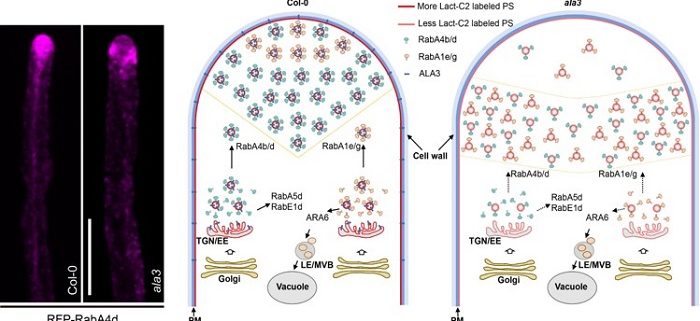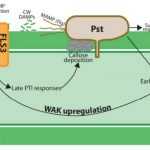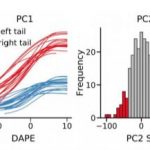A Tip-Localized Phospholipid Is Key for Polar Growth of Pollen Tubes
Zhou et al. demonstrate that phosphatidylserine regulates Rab GTPase-mediated vesicle trafficking and polar growth of pollen tubes. Plant Cell https://doi.org/10.1105/tpc.19.00844
Background: Pollen tube growth is an indispensable event during double fertilization in flowering plants. This peculiar polarized cell growth, in which the elongation occurs only at the tip area and the growth rate is exceedingly high, is distinct from that of most other plant cells. Importantly, the rapid tip growth requires intracellular transport machinery to continuously deliver essential cargoes to the apical growth site. There are two main kinds of crucial material transport patterns during tip growth: cytoplasmic streaming in the shank region and polarized vesicle trafficking at the apical area of the pollen tube. Because cytoplasmic streaming cannot reach the apical area of the pollen tube, tip-polarized vesicle trafficking is indispensable. In angiosperms, many vesicles with different diameters aggregate into an inverted-cone zone at the apical area of the pollen tube. However, the precise regulatory mechanism of tip-polarized vesicle trafficking remains unclear.
Question: What are the subcellular localization and biological function of phosphatidylserine (PS) in Arabidopsis pollen tubes?
Findings: Loss of Arabidopsis AMINOPHOSPHOLIPID ATPASE 3 (ALA3) function resulted in a marked decrease in YFP-RabA4b/ RFP-RabA4d- and FM4-64-labeled vesicles from the inverted-cone zone of the pollen tube tip, misdistribution of the certain intramembrane compartment markers and an obvious increase in pollen tube width. Additionally, PS was abundant in the inverted-cone zone of the apical pollen tube in Arabidopsis and mainly colocalized with markers for the trans-Golgi network/early endosome, certain post-Golgi compartments, and the plasma membrane. Loss of ALA3 function resulted in loss of polar localization of apical PS and significantly decreased PS distribution. We further demonstrated that certain Rab GTPases could colocalize with PS in vivo and bind to PS in vitro. Moreover, ALA3 and RabA4d collectively regulated pollen tube growth genetically. Thus, we propose that the tip localization of PS established by ALA3 is crucial for Rab GTPase-mediated vesicle targeting/trafficking and polar growth of pollen tubes in Arabidopsis.
Next steps: Because Rab GTPases can bind a variety of negatively charged phospholipids in vitro, we wish to know the precise mechanism and function of the interaction between Rab GTPases and different phospholipids.
Yuelong Zhou, Yang Yang, Yue Niu, TingTing Fan, Dong Qian, Changxin Luo, Yumei Shi, Shanwei Li, Lizhe An, Yun Xiang. (2019). The Tip-Localized Phosphatidylserine Established by Arabidopsis ALA3 is Crucial for Rab GTPase-Mediated Vesicle Trafficking and Pollen Tube Growth. Plant Cell. https://doi.org/10.1105/tpc.19.00844.




